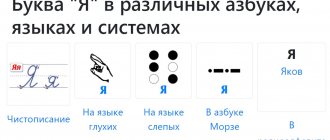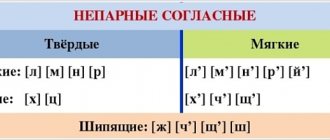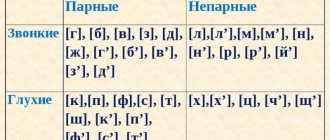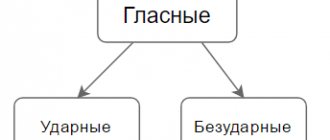4.1
Average rating: 4.1
Total ratings received: 60.
4.1
Average rating: 4.1
Total ratings received: 60.
Schoolchildren are introduced to consonant letters and sounds in the 1st grade. This article talks about soft consonants and the letters that represent them.
Softness
Only consonant sounds can be soft; the term “soft consonant letters” does not exist in the Russian language, since a letter is just a symbol of the alphabet.
Consonant sounds are called soft because when pronouncing such consonants, the middle back of the tongue is raised towards the hard palate to cause the so-called softness.
To understand how to determine the softness of a consonant sound, you need to monitor the movement of the tongue when pronouncing a particular word.
Softness as an element of transcription has its own designation: '.
In writing, gentleness is expressed in two ways:
- using the vowels i, e, ё, i, yu, which indicate the softness of the previous consonant sounds;
- using a soft sign (b).
A consonant sound is soft not because softness indicators are placed after it; on the contrary, softness indicators are placed after a consonant sound if this consonant sound is soft.
LiveInternetLiveInternet
- (0)
- AUDIO for children (2)
- POSTER and ANNOUNCEMENTS (2)
- APHORISMS QUOTES PARABLES about children (3)
- PREGNANCY. EXPECTING A BABY (2)
- CHILDREN'S LIBRARY (346)
- English for children (12)
- APPLIQUE (15)
- Education and communication (8)
- Educational pictures and cards (3)
- Magazines for children (6)
- Riddles (1)
- Book series (22)
- MOLDING (7)
- Mathematics for preschoolers (14)
- Primary school (9)
- The world around us (8)
- Experiences and Experiments (2)
- Preparing for school (13)
- Origami Paper Crafts (8)
- Educational literature (16)
- Developmental and creative tasks (22)
- Development of fine motor skills (7)
- Development of Thinking Attention Memory (19)
- Speech development Reading Primers (50)
- TESTS for children (2)
- Learning to write Copybooks (26)
- Learn to draw (20)
- Fiction (88)
- Encyclopedias and reference books (8)
- VIDEO HALL (20)
- Education and development of children (3)
- Cartoons (6)
- Educational video lessons and videos (11)
- RAISING CHILDREN (63)
- ALL ABOUT NEWBORN (1)
- PUZZLES and Tricks (1)
- CHILDREN'S WORK (3)
- BABY FOOD (0)
- CHILDREN'S HEALTH (3)
- GAME LIBRARY (159)
- Game - dramatization (1)
- Educational games (70)
- Flashcards (5)
- DIY games and toys (53)
- Computer games (2)
- Puppet theater (1)
- Printed board games and lotto (19)
- Finger games (5)
- Outdoor games (9)
- Role-playing game (1)
- ART PAINTING for children (0)
- PIGGY BANK OF PARENTAL EXPERIENCE (52)
- CREATIVITY CREATIVITY TRIZ (2)
- Speech therapy (34)
- Speech development and correction (20)
- Advice from a speech therapist (14)
- MASTER CLASSES (27)
- Trowel (358)
- Applique (41)
- Volume applique (12)
- Quilling (1)
- Clip art and pictures (2)
- Construction (2)
- Modeling (52)
- Origami (8)
- Paper crafts (92)
- Crafts made from natural materials (8)
- crafts from various materials (88)
- Drawing (54)
- METHODS SYSTEMS EDUCATIONAL PROJECTS (11)
- Montessori Method (6)
- TEPLYAKOVA METHOD (3)
- MUSIC and SONGS for children (0)
- DIARY NAVIGATOR (15)
- NEWS and ANNOUNCEMENTS (1)
- CHILDREN'S EDUCATION (19)
- Preschool education (1)
- Primary school (18)
- High school (3)
- TEACHING PRESCHOOL CHILDREN (398)
- Quizzes and Competitions (1)
- Choosing a profession (3)
- Geography for kids (1)
- School Readiness (18)
- Riddles (14)
- Foreign languages (11)
- Educational cards (8)
- Complex classes (18)
- Mathematics (27)
- The world around us (31)
- Writing Copybooks Workbooks (23)
- Why (7)
- Developmental tasks (41)
- Development of Attention (5)
- Development of fine motor skills of the hand (46)
- Development of Thinking (27)
- Memory Development (4)
- Speech Development (39)
- Sensory development (12)
- Savvy (1)
- Thematic weeks (25)
- Reading (71)
- Economics for kids (11)
- Etiquette for kids (1)
- ONLINE resources (16)
- EXPERIMENTS and EXPERIMENTS for children (28)
- Entertaining astronomy (1)
- Entertaining biology (4)
- Entertaining geology (1)
- Fun math (1)
- Entertaining physics (16)
- Entertaining chemistry (5)
- RECREATION and TRAVEL for children (4)
- USEFUL PROGRAMS (1)
- SAFETY AND CONDUCT RULES (6)
- HOLIDAYS CONGRATULATIONS GIFTS (162)
- February 23 (19)
- March 8 (9)
- Cosmonautics Day (2)
- Birthday (17)
- Teacher's Day (5)
- Maslenitsa (3)
- New Year (92)
- Easter (17)
- PRESENTATIONS for children (0)
- CHILDREN'S PSYCHOLOGY (17)
- EDUCATIONAL TOYS (14)
- Constructors (3)
- Mobiles and pendants (3)
- Soft educational toys (1)
- Creativity kits (1)
- Board games (2)
- Puzzle Sorters (1)
- Pyramid Cubes (1)
- CHILD DEVELOPMENT (53)
- Intrauterine development (1)
- from 0 to 1 year (20)
- from 1 to 2 years (20)
- from 2 to 3 years (8)
- from 3 to 4 years (7)
- from 4 to 5 years (3)
- from 5 to 7 years (3)
- COLORING BOOKS (48)
- Labyrinths (5)
- Stroke (2)
- Seasons coloring pages (2)
- Coloring pages for kids (11)
- Holiday Coloring Pages (4)
- Animal coloring pages (4)
- Buildings and houses coloring pages (1)
- Cartoon coloring pages (1)
- Educational coloring pages (4)
- Online coloring pages (4)
- Color by number (2)
- Bird coloring pages (1)
- Flora coloring pages (4)
- Transport coloring pages (2)
- SERIES of coloring books (3)
- FAIRY TALE THERAPY (42)
- (25)
- (51)
- TESTS and DIAGNOSTICS for children (3)
- PRODUCTS for children (0)
- PHYSICAL EDUCATION (4)
- PHOTO GALLERY (1)
- ENCYCLOPEDIA and DICTIONARIES (0)
Letters that represent soft and hard consonants
The letters b, c, d, d, z, k, l, m, n, p, r, s, t, f, x can denote both hard and soft consonant sounds. This is reflected in the following table:
| Letters | Sounds |
| b | [b], [b'] |
| V | [in], [in'] |
| G | [g], [g'] |
| d | [d], [d'] |
| h | [z], [z'] |
| To | [k], [k'] |
| l | [l], [l'] |
| m | [mm'] |
| n | [n], [n'] |
| P | [p], [p'] |
| R | [р], [р'] |
| With | [s], [s'] |
| T | [t], [t'] |
| f | [f], [f'] |
| X | [x], [x'] |
The consonants presented above are called paired according to softness and hardness.
When comparing the words mom ([mama]) and mint ([m'ata]), one can come to the conclusion that in writing both words use the same letter - m, but the pronunciation of the sounds is different. Only in the second case is the consonant sound soft. This example shows the relationship between a consonant letter and the vowel letter behind it.
WHICH VOWEL LETTERS SOFTEN CONSONANTS
Help me find words with the same root ex. 191 Compose a text of 10 sentences about the New Year holiday. Use 3 participial phrases and 4 participial phrases. Highlight everything and mark 2nd grade! Urgent! We need your help! Help with task 2. Please!!! Urgent! Write out words with an unstressed vowel from the text: first, words with an unverified unstressed vowel, then words that are verified with stress. “In the forest” It’s good in the forest. A warm breeze is blowing. The blackbirds are singing. There are flowers in the meadow. There are berries in the grass. A mushroom grew under a birch tree. There is a mole hole in the pine tree. A yellow leaf fell from a pine tree. Autumn will come soon. Grade 2! Urgently! We need your help! 1. Write out words with an unstressed vowel from the text: first, words with an unverified unstressed vowel, then words that are verified with stress. “In the Forest” Good in the forest! A warm breeze is blowing. The blackbirds are singing. There are flowers in the meadow. There are berries in the grass. A mushroom grew under a birch tree. There is a mole hole in the pine tree. A yellow leaf fell from a pine tree. Autumn will come soon. 1. Write out words with an unstressed vowel from the text: first, words with an unverified unstressed vowel, then words that are verified with stress. 2. Find synonymous words: Blizzard, hot, blizzard, lie, deceive, hot. 2nd grade! Urgent! We need your help! "In the forest" Good in the forest! A warm breeze is blowing. The blackbirds are singing. There are flowers in the meadow. There are berries in the grass. A mushroom grew under a birch tree. There is a mole hole in the pine tree. A yellow leaf fell from a pine tree. Autumn will come soon. 1. Complete a complete analysis and characterization of sentence 6. 2.Copy out words with an unstressed vowel from the text: first, words with an unverified unstressed vowel, then words that are verified with stress. 3. Find synonymous words: Blizzard, hot, blizzard, lie, deceive, hot. Write in one word what part of the sentence is the word “this” in sentence 1. (1) The new sailor’s surname is somewhat strange - Fuchs, but, you know, a surname is a gainful thing, and Lom also whispered in my ear that this Fuchs - a treasure, not a sailor: he is well versed in maps. THANKS IN ADVANCE FOR YOUR REPLY!!! NEEDED VERY URGENTLY!!! I give 15 points!!! 2 sentences for one diagram. It is necessary to make all the schemes. Help!!! Essay on the topic: My room. Write an example. How to write it. Please help!!! I give 50 points. Exercise 361. Please help me answer the questions where task number 2 is!
How to teach a child to distinguish between hard and soft consonants (grade 1)
The transition from kindergarten to first grade is not only an important and joyful event in a child’s life, but also a lot of stress, because at school children are forced to receive and assimilate a large amount of information in a short time. However, not every topic can be easily mastered by a new student. For example, some first-graders find it difficult to learn to distinguish between hard and soft consonant sounds in the short period of time indicated in the 1st grade curriculum.
Division into vowels and consonants
How to help your child learn to distinguish between soft and hard consonant sounds
Additional signs by which a consonant sound can be classified into one category or another
How to introduce a first grader to hard and soft consonant sounds in a playful way?
In this case, parents should come to the aid of the student. But it is difficult for fathers and mothers who do not have a pedagogical education to independently explain the difference in sounds to their baby. Let's try to look at the basic principles that will make this much easier.
What have we learned?
Soft consonant sounds are characterized by the fact that when pronounced, the middle back of the tongue is raised towards the hard palate. This is what allows you to determine the softness of a consonant sound. Soft consonant sounds in writing are indicated by consonant letters; in transcription, the sign ' is used. The softness of consonant sounds is expressed thanks to the vowel letters i, e, ё, i, yu and the soft sign indicating the softness of consonant sounds. In the Russian language there are letters that always indicate a soft consonant sound: й, ч, щ. The following letters can represent soft and hard sounds: b, v, g, d, z, k, l, m, n, p, r, s, t, f, x.
How to introduce a first grader to hard and soft consonant sounds in a playful way?
- After writing down pairs of words that include soft and hard consonants, you can ask your child to highlight certain sounds with the following colors:
- vowels - red;
- hard consonants – in blue;
- soft sounds - green.
- Parents can name words for their children by asking them to identify the hard and soft consonant sounds in them by ear. For the first attempts, you should select three-letter words starting with a consonant. As the child’s skills in identifying soft and hard sounds improve, the length of words needs to be increased, and the task must also be made more complex, starting words with a vowel and including hard or soft signs in them.
- You can modify the previous game by changing roles. Let the student come up with words ordered by the parent. For example, the elder will ask you to name a word of five letters, while the first must be a vowel, and the presence of a soft consonant B is required. The answer may be - RESULT or WRAP. By showing imagination, you can make the task even more difficult. For example, name words by category (food, sports, travel, summer, etc.).
- You can also play using various kinds of objects. Balls, colored cubes, jump ropes, and cards with numbers are great for learning the classification of consonant sounds. The latter can be used in the case when a first-grader needs to determine which sound in a word is soft or, conversely, hard, or how many different sounds there are in a given word. You can throw the ball, calling the required sound, and jump on the rope if you make a mistake.
- An interesting educational game can be played with cubes of four colors: red, blue, green, yellow. Each cube is needed in a quantity of several pieces, because it is easy to guess what sounds they will represent. Yellow color is an additional color, one that was not described earlier, will mean a hard or soft sign.
There are many variations of this game, below are just the main ones:
- The driver lays out a diagram of the word from the cubes, and the player selects the appropriate word from it. Thus, the scheme: “GREEN – RED – BLUE – GREEN – RED – GREEN – YELLOW” corresponds to the word “BEAR”. You can make the task more difficult or easier by reducing or increasing the number of cubes or colors. The main factor is that the first grader takes not only the place of the player, but also the driver, that is, he performs the task of both selecting a word and drawing it up schematically.
- You can add a rating to the game, using the sum of points scored to determine the winner at the end of the competition. Determining in turn the roles of the driver and the guesser, guess the word, and give a certain number of points for each color of the cube. For guessing the letter indicated by the yellow cube, count five points, because in its place there can only be two letters; for the sound hidden under green and blue colors - fifteen each; and for the vowel indicated by the red cube - ten. Soft and hard consonants add up to 36 sounds, so finding them is more difficult than lower vowels.
- As in the previous game, you can add a distinction by category here. However, here it will be more of a hint than a complication. After narrowing the search range, the word will be found easier and faster.
- For children just starting their journey in the phonetics of the Russian language, you should select a game program that is somewhat simpler than the previous ones. For example, you can list various objects located in the apartment in order to use such a clear example to explain which of the sounds in a word is soft and which is hard. In such an activity, preference is given not only to the clarity of the subject, but also to speaking out loud. If there is a board in the room, it is best to write the word on it, dividing it into syllables and determining the gradation of sounds with the child. You can also use a regular sheet of paper for writing, then with the help of colored pencils it will be possible to use the color designation that is offered in the previous game.
- The next game is best played in a group of several children. Depending on the skills of the other students, the first player names a word of any length and complexity, the next participant spells out this word, naming the degree of each consonant sound (whether it is soft or hard). Having indicated everything correctly, the player comes up with a word of the same difficulty for the next one, and so on in a circle. The person who answers incorrectly leaves the game, and the last remaining participant becomes the winner.
- As soon as it becomes clear that your elementary school student has become familiar with the basics of parsing consonant sounds, you can move on to the most serious task: composing a fairy tale from words chosen by dad or mom. Having made a diagram of colors and putting these schemes into sentences, the adult, with hints, helps the child come up with a short story similar to the word “BEAR” compiled above. The scheme should be prepared and thought out in advance, which adds certain difficulties and time costs, however, as practice shows, first-graders love this game the most.
How are soft sounds indicated in writing?
As a rule, soft consonant sounds in writing can be indicated in different ways.
With a soft sign. However, we must remember that the soft sign only indicates the softness of the paired consonant. If we have a hissing one in front of us, its softness cannot be indicated with a soft sign. Hissing ones are either always hard (in which case they cannot be softened) or always soft (in which case a soft sign is unnecessary in this situation). After sibilants, the soft sign performs a grammatical function, that is, with its help, nouns of the 2nd and 3rd declension are distinguished.
Studying the Russian language already in the 2nd grade, children learn about the dual role of the letters E, E, Yu, Ya. If these letters appear after a paired consonant, they are read E, O, U, A and at the same time indicate the softness of the previous consonant: [L'E ], [L'O], [L'U], [L'A].
Similar to the first case, after sibilants E, Yo, Yu, Ya cannot indicate the softness of the previous consonant, therefore spelling E and Yo after sibilants is difficult and is also learned as a rule and also performs the grammatical function of distinguishing parts of speech. For example , the word “arson” is a noun, and the word “arson” is a verb.
In what cases is it not necessary to indicate softness in writing?
Some soft consonant sounds and combinations are not friendly with a soft sign.
This is an unpaired soft sound [Y']. A soft sign is never placed in its field.
In the combinations CHK, CHN–NCH, CHV, CHT, ShchN–NSCH, RShch, a soft sign is not needed.
It is not required in combinations ST, CH, ZD, ZN and some others, in which S or Z are softened when pronounced before a soft consonant: verses [S'T'], difference [Z'N'], etc.
After a sibilant, a soft sign usually performs a grammatical function, but can also be dividing: “sews”, “whose”, etc.





